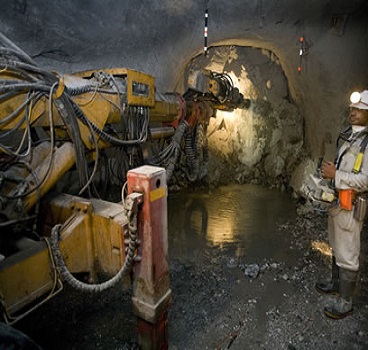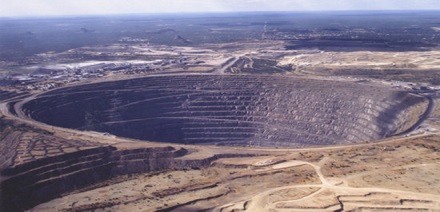Palabora
Mining Company was founded in South Africa in August 1956. The company
is owned and managed by Rio Tinto. 57.7% owned by Rio Tinto and Anglo
American has a 16.8% stake. On September 5, 2012, the two companies
announced their intention to sell their respective interests in
Palabora. On December 11, 2012, Rio Tinto announced that it reached an
agreement with a consortium binding sales that are committed to the
sustainable management continuously from Palabora. The consortium is
comprised of South Africa and China entity led by the Industrial
Development Corporation (IDC) of South Africa Limited and China’s Hebei
Iron & Steel Group. The sale agreement was concluded in July 2013,
and the company name changed from Palabora to Palabora Copper Mining
Company (Pty) Limited.
Located 360km north east of
Pretoria, close to Kruger National Park, Palabora is South Africa’s
leading copper producer and also a major source of vermiculite and
baddeleyite (zirconium oxide). The majority shareholder in Palabora
Mining Co. is Rio Tinto plc (57.7%) and Anglo-American. Palabora Copper
(Pty) Limited and beneficiates extract copper and other by-products in
Ba-Phalaborwa area of Limpopo Province. Palabora just fine copper
producer South Africa and supply the local market with 85% of copper
needs.
Copper operations consist of
underground mines, a concentrator, a copper smelter with anode casting
facilities and associated acid plant, an electrolytic refinery tank
house, rod casting plant, magnetite separation plant and plant
by-product recovery. Vermiculite operation comprises open pit mining
operations and recovery plants. Open-pit mining began in Palabora in
1964 and ended in 2002 when the economy reaches a depth hole final. The
development of an underground mine to work ore remaining under the
bottom of the pit began in the last years of open pit mine production,
at a cost of about $ 465m, with the prospect of life of over 20 years in
the underground operation. Integrated copper production complex has a
metal-refining capacity of 135,000t / y, despite the change to
underground mining means that some of this capacity is now redundant.
Operation employs about 1,800 people.
Palabora containing magnetite,
vermiculite, apatite, zirconium, titanium and uranium and copper.
Deposit is hosted in a complex consisting of alkali particularly frozen
pyroxenite with events pegmatites, foskorite and carbonatite. Three
separate mineralized zones have been identified in outcrop 20km² complex
surfaces, from the north is rich in phosphates and the center
(Loolekop) zone forms the basis for this Palabora copper production.
Copper ores are hosted in carbonatite pipe where the value is usually
concentric with the highest value (1.0% copper) at its core. High grade
mineralization extends down the center of the projected end of the pit
open floor. Underground mine has been developed on the proven reserves
225Mt at 0.7% copper, plus the possibility of additional reserves of
16Mt grading 0.49% copper. At the end of 2005, proven and probable
reserves of 112Mt levels reached 0.56% copper, representing a
significant reduction of the tonnage and grade quoted previous year. Rio
Tinto recorded a US $ 161m asset write-down in the 2005 accounts to
reflect this.
 Throughout the 35-year life, Palabora often at the forefront of
technological development of surface mining. The main feature is the use
of trolley-assist systems for haul trucks out of the pit, to save
diesel, and it was one of the early users both in pit crushing and
computerized despatching trucks. Open pit fleet consists of about 20
Euclid and Unit Rig trucks, with the four P & H 2100XPA and 2,800
shovel. Cargo truck monitored using Pit control systems on-board
overload the shovel, associated with Modular Mining Systems’ despatching
and monitoring program. Fuller-Traylor rotating in-pit crusher, with a
nominal capacity of 5,000t / h, feeding the main conveyor that carried a
1.8-width crushed ore drift up on the pit wall to the rough surface of
the ore stock.
Throughout the 35-year life, Palabora often at the forefront of
technological development of surface mining. The main feature is the use
of trolley-assist systems for haul trucks out of the pit, to save
diesel, and it was one of the early users both in pit crushing and
computerized despatching trucks. Open pit fleet consists of about 20
Euclid and Unit Rig trucks, with the four P & H 2100XPA and 2,800
shovel. Cargo truck monitored using Pit control systems on-board
overload the shovel, associated with Modular Mining Systems’ despatching
and monitoring program. Fuller-Traylor rotating in-pit crusher, with a
nominal capacity of 5,000t / h, feeding the main conveyor that carried a
1.8-width crushed ore drift up on the pit wall to the rough surface of
the ore stock. Underground mine is block caving operation, the first such system to be
used in metal mining in South Africa. With the introduction of
underground operations, ore output had fallen from the 82,000t / d
achieved in the previous open pit to 30,000t / d. However, the
transition to underground production has proved problematic, especially
in relation to the handling of large ore in drawpoints, and I have
struggled to meet production targets. Average output during the end of
2003 was about 20,000t / d, and additional secondary breaking system is
being built to help alleviate the bottleneck drawpoint.
Underground mine is block caving operation, the first such system to be
used in metal mining in South Africa. With the introduction of
underground operations, ore output had fallen from the 82,000t / d
achieved in the previous open pit to 30,000t / d. However, the
transition to underground production has proved problematic, especially
in relation to the handling of large ore in drawpoints, and I have
struggled to meet production targets. Average output during the end of
2003 was about 20,000t / d, and additional secondary breaking system is
being built to help alleviate the bottleneck drawpoint.
Shaft sinkers contracted to
install the service shaft and axle production in the main-1,280m, while
RUC Mining Contractors have carried out underground development. This
includes driving around 36km of tunnels plus the underground crusher
station, ore handling infrastructure and weaken level to block the first
cave, located 500 m below the base of the final hole. Destroying the
station was equipped with four ThyssenKrupp 900T / h double-toggle jaw
crusher feed conveyor which connects to the shaft 1.32km production.
Palabora employs one of the most
complex recovery circuit installed in each copper mine, producing eight
metals, minerals and chemical products in about 20 different varieties
and grades. The complex includes a concentrator, a copper smelter and
refinery, is now capable of producing 135,000t / y of copper plus
by-product. Phosphate-rich tailings sent to Foskor, while Palabora sells
its own copper, precious metals, nickel, zirconium, magnetite and
vermiculite in domestic and world markets.





